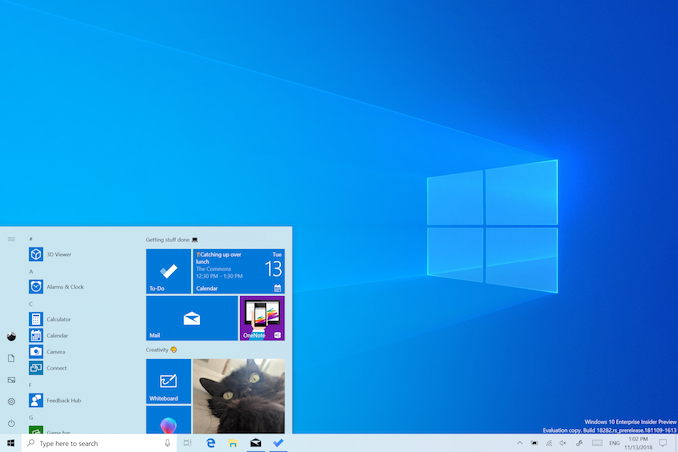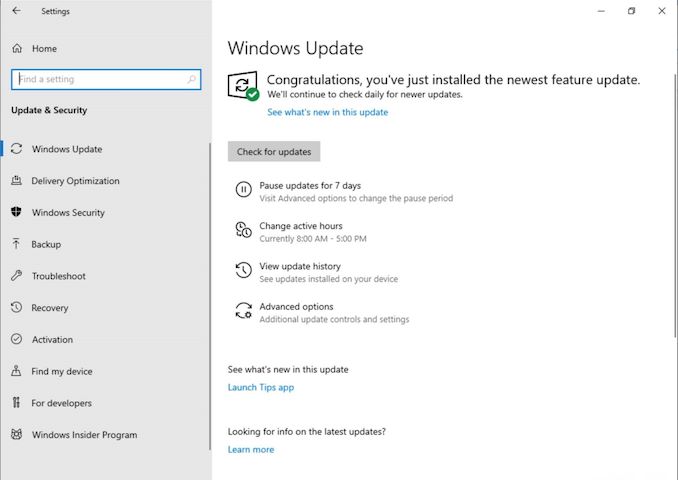A New Approach To Updates: Windows 10 May 2019 Update Available Today
by Brett Howse on May 21, 2019 9:15 PM EST- Posted in
- Operating Systems
- Software
- Microsoft
- Windows 10

For those eager to get the latest and greatest production build of Windows 10; good news. For those who would rather watch from the sidelines until the kinks are worked out; good news. Today Microsoft has officially launched the spring 2019 update for Windows 10, affectionately called the Windows 10 May 2019 Update. There’s a few new features under the hood, but the biggest change to Windows 10 this time is not a new feature you may or may not use, but instead a new approach to updates. And, after almost four years of users not being in control, Microsoft has put the control back in the hands of the people using their OS. Finally.
I’m not going to pine on about days gone past, but one of the biggest changes to Windows 10 when it launched was that the update system was going to be better. Improved. More reliable. Except it wasn’t. Some changes, such as the cumulative updates, have been a huge relief for people setting up new machines, since they no longer needed to update their computer for several days. An update comes every month which should have everything you need to get you to current in one batch. This was a win for end users. However, Windows 10 also brought about a new idea called feature updates, where occasionally, a new version of Windows would come down the same pipe as a normal update. Assuming everything was well tested, the update should install with little fanfare, but as we know that’s not been the case. Windows is on far too many machines to make any update easy, and Microsoft’s feedback mechanism for update issues was not being monitored as it needed to, which lead to multiple feature updates with enough major problems that even the last update from October is only now being pushed out to some machines.
So today we get Windows 10 1903, or the May 2019 Update, and home users will finally get an option to pause updates even if they are using Windows 10 Home. It’s a small step, but coupled with a very measured rollout, hopefully this will be the smooth update Microsoft has been craving for the last couple of years. For those looking for further transparency, Microsoft has a Windows release health dashboard, which shows the status of current known issues, letting you know ahead of time if you may have an incompatible piece of software or hardware.
There are of course new features as well, since this is in fact a feature update for Windows 10. There’s a new light theme, providing a refreshing look for Windows 10 which pairs nicely with the dark mode that arrived a couple of versions ago. Cortana is no longer part of the search bar, and now lives on its own app icon on the task bar. More default applications can now be removed.
There’s more complex features as well, such as Windows Sandbox, which allows you to run an application in a virtualized container for testing without it having access to the system files. Think of it like Hyper-V, but without the complexity. It’s not as powerful as Hyper-V, but it’s also much easier to set up and use.
There’s a few other features as well that we’ll go through in a more comprehensive article after we’ve had time to dig through some of the new abilities. That being said, updates are now offering fewer and fewer big changes, which makes sense due to the maturity of Windows 10 now. Plus, with the lack of stability, it makes sense to offer less user-facing features that are more stable, rather than continue to offer a multitude of new things that may or may not get used.
For those looking to get a jump-start on the upgrade process, Windows 10 May 2019 Update is currently rollout out via Windows Update where you can just check for updates, and you’ll receive it if your computer doesn’t have any blocking hardware or software. Microsoft is taking a very measured and cautious approach here, which is the right thing to do. For those that don’t want to wait for Windows Update, you can always check out the Windows 10 Download page to get the update right now.
Source: Windows Blog












43 Comments
View All Comments
austinsguitar - Tuesday, May 21, 2019 - link
that sandbox feature is actually genius.ooogemaflop - Wednesday, May 22, 2019 - link
Windows 7 had XP mode and VMs and Sandboxes have been around yearsAlexvrb - Wednesday, May 22, 2019 - link
This is different from XP mode both in intent and function. Yes, VMs with sandboxing capability have been around for some time... but nothing this fast and simple to use. Plus it's built in, and free. So while it's not a revolutionary concept, it's still a really solid addition.HStewart - Wednesday, May 22, 2019 - link
Not sure if this can do this - but what would be nice is browser mode that complete in virtual machine, this mean any virus or adware that comes in is only in the virtualization of the browser. Absolute no way hat any process can access outside, and optionally allow any file transfer to be done by protected scan channel - or text copy mode only.ooogemaflop - Wednesday, May 22, 2019 - link
like what sandboxie does lolBedfordTim - Wednesday, May 22, 2019 - link
That has been available as an optional component in the Pro version for some time.jabber - Friday, May 24, 2019 - link
As PWN2OWN has shown many times...sandboxes can be bust wide open.Koenig168 - Tuesday, May 21, 2019 - link
"Microsoft has put the control back in the hands of the people using their OS. Finally." - Pausing updates is a small concession to WIndows Home users but that is hardly putting control back in the hands of people. For there to be a real choice, Windows need to have an option to select the updates to install and if desired, to disable the Update feature completely.Power users can of course disable Windows Update manually. I'm still on Windows 10 Pro version 1709 (recently updated to May 2019 patches before disabling Update again). There should be an easier way for less tech savvy users to do this.
Zizy - Wednesday, May 22, 2019 - link
The problem is that if everyone could mess with updates, you couldn't rely on everyone having feature X. The nice bit about W10 is that you need to write stuff for the newest Windows and assume everyone can run the thing. No need to mess with old Windows compatibility or anything.Mr Perfect - Wednesday, May 22, 2019 - link
Or you go to help someone fix their computer, only to find it's a year out of date. Bonus points if it's broken BECAUSE it's out of date.Also, I'm curious how Koenig168 got the May updates on 1709. It's supposed to be EOL now, unless you have Enterprise or Education, but they said they have Pro. https://support.microsoft.com/en-us/help/13853/win... My guess is it was just May updates for .NET or something that was still in support.